It was my first foray back out into the real world of watches in almost a year. Not quite past the pandemic, but a summer break from lockdowns and hardcore restrictions had finally led me back to Switzerland to enjoy the company of ticking treasures and their makers.
I traveled to Geneva on a drizzly day with a few different errands in mind and an event to attend. But before hitting those, I stepped off the train, out of the rain, and into a freshly renovated hotel lobby for a cup of tea and an easy chat with a watchmaker I already knew and a designer I hadn’t yet met.
They had watches from a new brand in tow: Oskar Pascal is the brainchild of a pair of Swedish brothers who were neither previously involved in the watch industry nor are they watchmakers. And I was about to see their very first watch: a cleanly designed chronograph bearing the cryptic name of OP483.
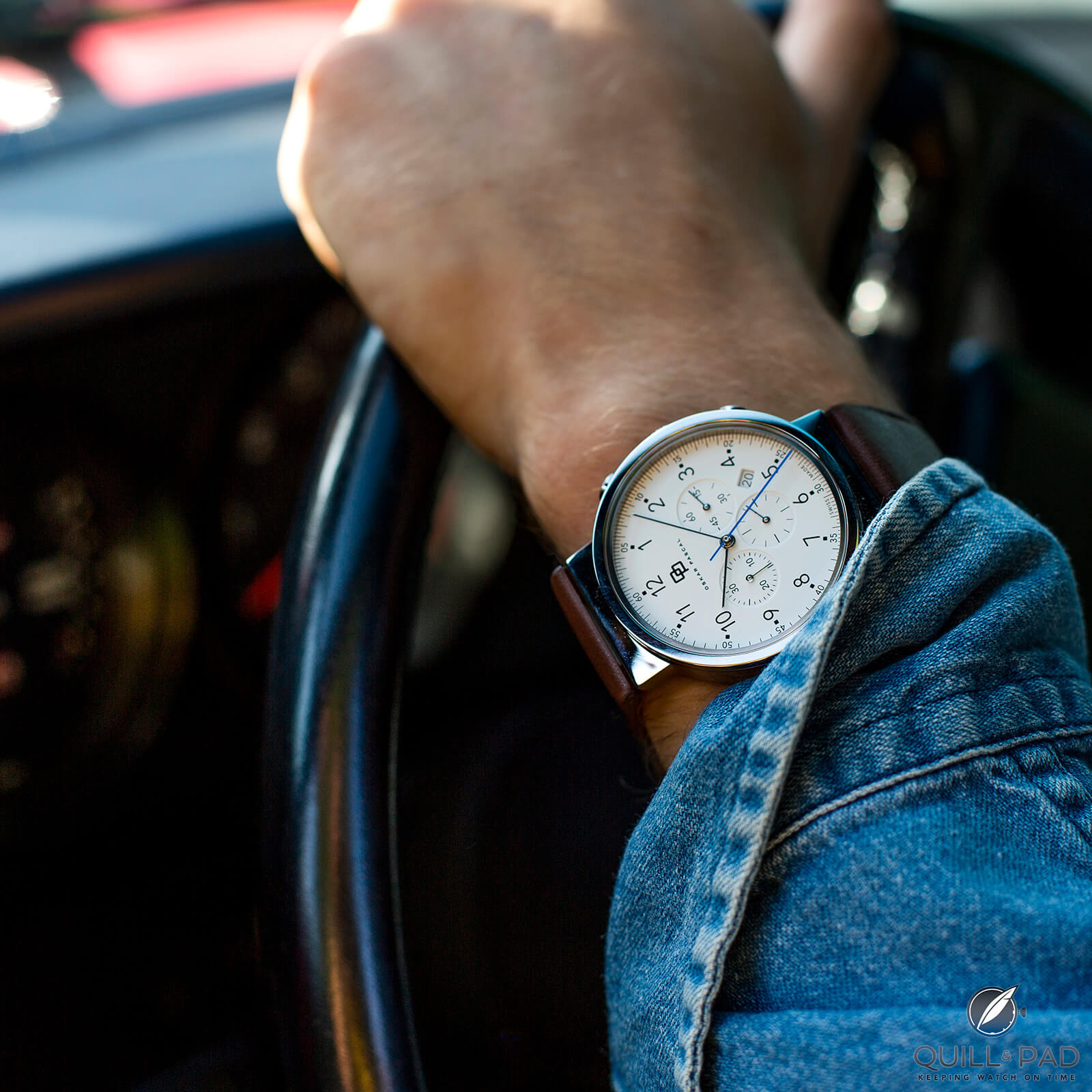
Oskar Pascal OP483 chronograph
Oskar Pascal
The Swedish brothers are Jakob and Petter Paulin, and it is Petter who I had the pleasure to meet on this damp day in late July. But it wasn’t just the promise of seeing something entirely new that attracted me enough to learn more about this new watch: it was the watchmaker sitting across from Petter who warranted the curiosity I was feeling.
This watchmaker was Cyrano Devanthey, who you may be familiar through his work with Urwerk and, more recently, Oscillon.
About four years ago Jakob Paulin, a research engineer in Sweden, had an idea regarding something he called Pods (more about those below) and reached out to his sibling, Petter – a designer. That signaled the start and the two founded Oskar Pascal, a brand name combining Jakob’s middle name, Oskar, with the term Pascal, a unit measuring pressure and mechanical tension named for French physicist Blaise Pascal.
“We tried out hundreds of names as we didn’t feel comfortable putting our own last name on the watch,” Petter Paulin laughed as we discussed the moniker.
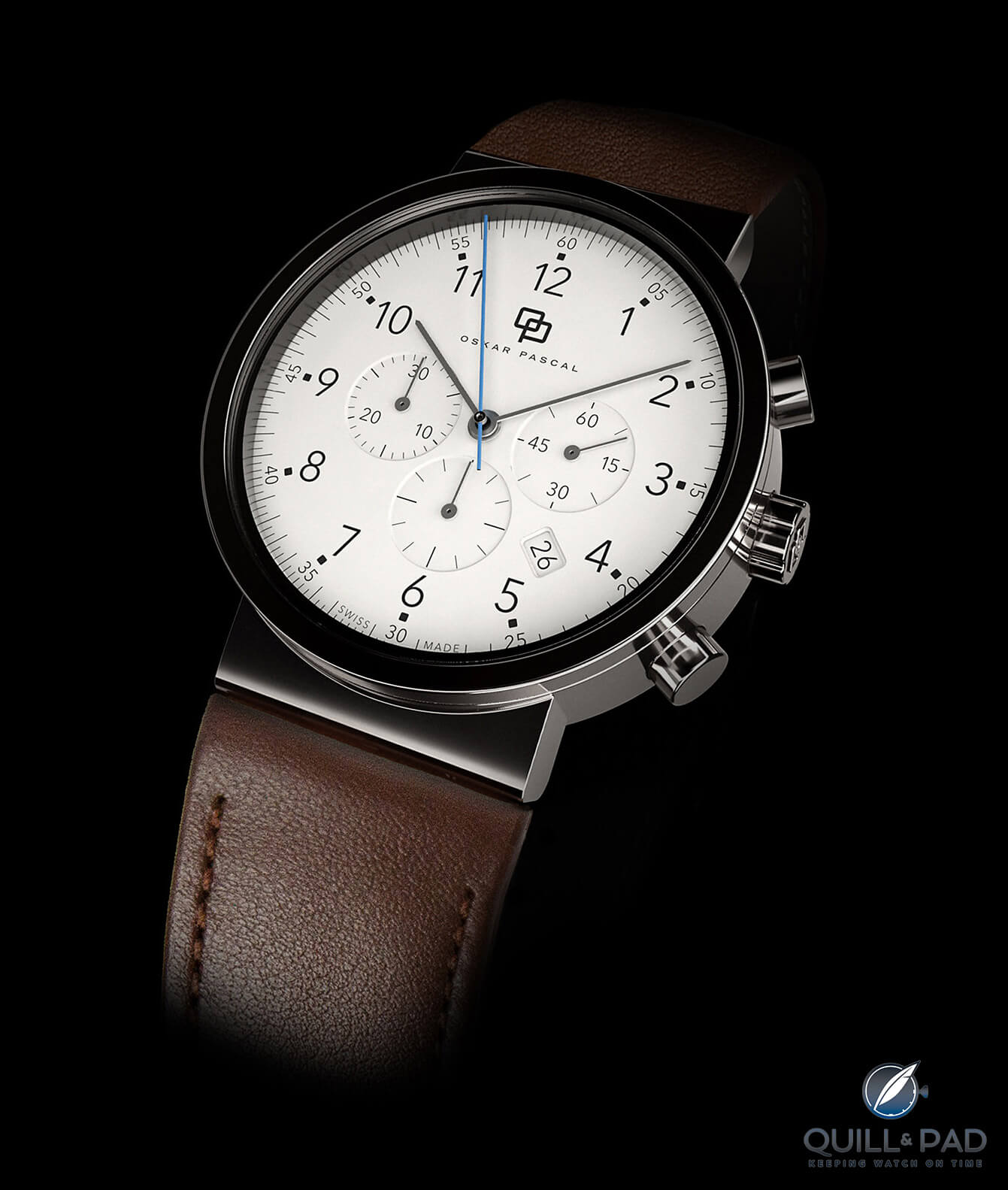
Oskar Pascal OP483 Ultra Shine
Jakob and Petter worked uncompromisingly on every detail of their creation built around the idea of the Pods, persistently planning and developing the details of their creation for four years, contacting the foremost suppliers for each component. After years of research and travels to Switzerland, they found the best collaborators for every part of the watch they envisioned.
But it is in particular two elements of this watch that make it unique in comparison to other luxury watches, and perhaps this is where the inherent “Swedishness” of the creation comes to the fore.
The first of these is the case – and the “Pascal” in the brand name is very fitting here as a tribute to the unique quality and strength of the material that the brothers have chosen to use as an exclusive case material: ZR01. This material isn’t just rare: they are the first to use it in watchmaking.
Oskar Pascal OP483: sheathed in ZR01
ZR01 is an amorphous alloy based on zirconium. It is considered one of the hardest metals in the world and is even used by NASA.
ZR01 in this form has a hardness of 483 on the Vickers scale of hardness – hence the name of the chronograph, OP483 – and is three times harder than stainless steel. The Oskar Pascal OP483 is the only watch ever to be crafted in ZR01.
The cases are 3D-printed in ZR01. After Heraeus 3D prints 720 layers of the material in Germany, the strong case blanks are sent to a specialist in La Chaux-de-Fonds for extremely precise CNC machining. The ultra-hard case is then hand-polished eight times for a mirror finish (the Ultra Shine model) and unprecedented scratch resistance.
Heraeus is one of the world’s leaders in amorphous metals. Since Heraeus owns the license to print the ZR01 patented by a Swedish company, the Paulin brothers know that these are the only cases made of it.
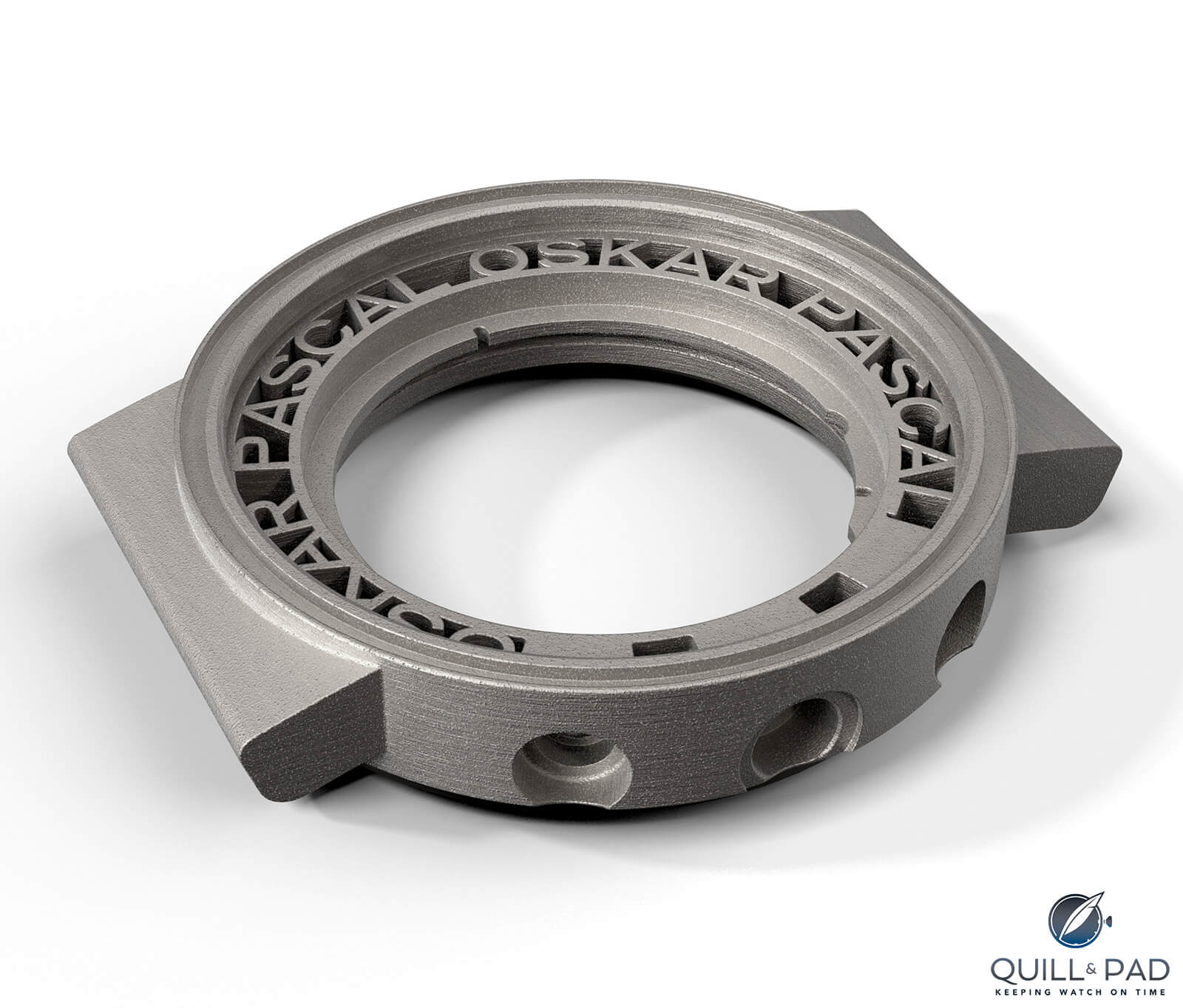
Oskar Pascal OP483 case in ZR01 after 3D printing
Heraeus 3D prints the case blanks using technical drawings from the Paulins and Devanthey. But, as Devanthey explained, they are not able to 3D print this case to the perfection that is needed for a luxury watch of this quality, so they “print” blanks that are sent to La Chaux-de-Fonds to be finished by the experts. The Vickers hardness of 483, which is also harder than grade 5 titanium, makes the machining tricky.
According to Oskar Pascal’s Swiss-based case maker, ZR01 is not only harder and more challenging to machine than other metals, the polishing is extremely time consuming as well. Petter related that, “[the case makers] actually recommended not to make the Ultra Shine model at all! Too expensive, they said.”
“When comparing finished watch cases, ZR01 is in the same price range as platinum,” Paulin continued. “When comparing raw materials, ZR01 is about 200 times more expensive than grade 5 titanium.” It is important for prospective clients to know how just exclusive ZR01 is since it is a new material and Oskar Pascal is an as-yet unknown brand.
This case also holds a detail that I found very interesting: through the 3D printing process, they were able to integrate shapes into the case structure that would otherwise be impossible – so the words “Oskar Pascal” are integrated into the case band under the dial (which means no one gets to see them but the watchmakers). But I found this to be a very compelling detail that Devanthey came up with. “It’s sort of a secret signature,” Petter Paulin joked.
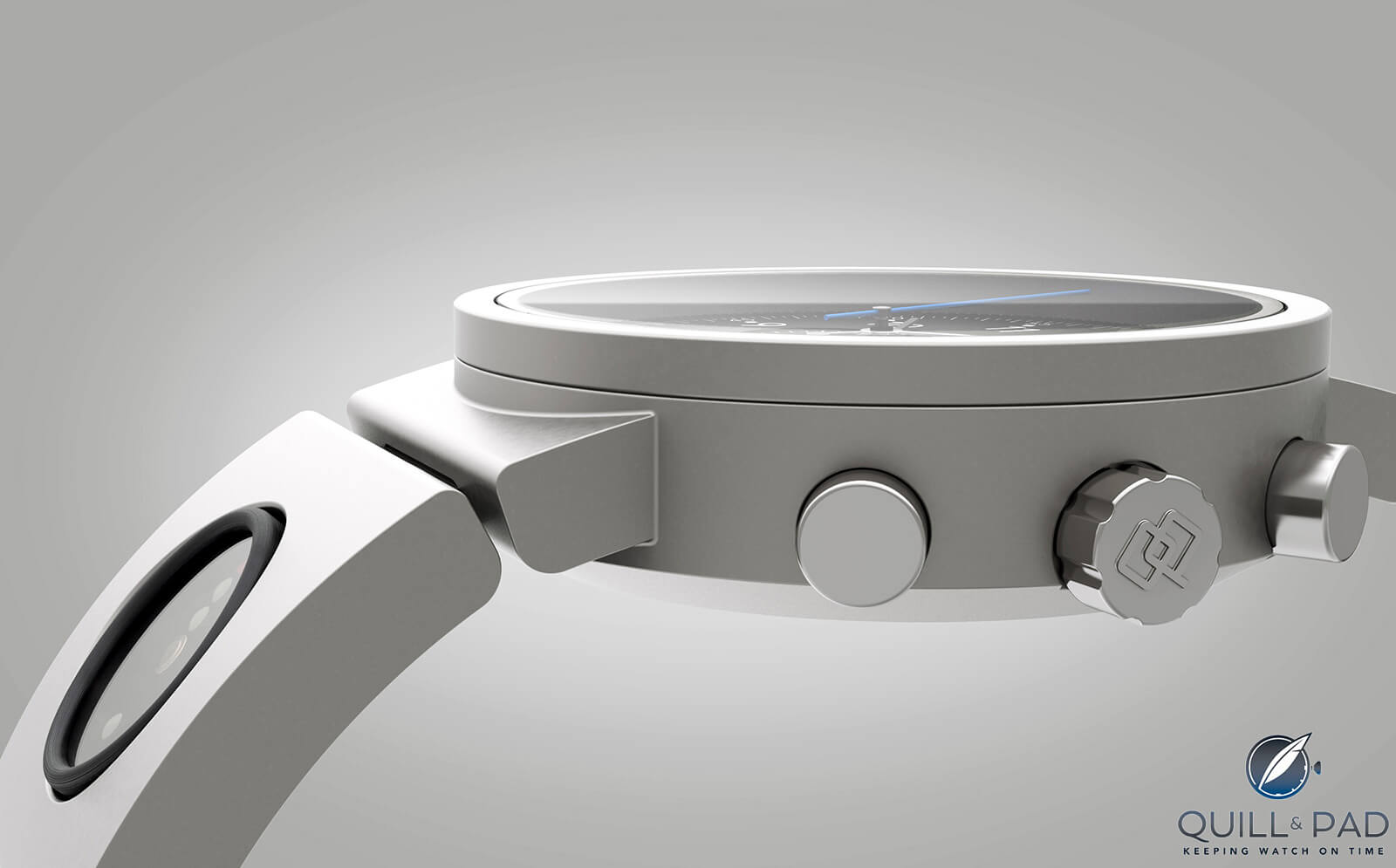
Oskar Pascal OP483 Deep Silver case band, crown, and pushers with Pod
This case also incorporates a screw-in bezel. “We made sure to incorporate all the best details for a long-term vision and service,” said Devanthey.
“We said to ourselves right from the start: we’re going to make this watch like we want to make it and worry less about the end price,” added Paulin.
Oskar Pascal OP483: the Pods
The so-called Pods are the second element that sets this watch apart, in essence constituting a new category of wearable technology equipped with individual technology that can be added or interchanged with strong focus on mechanical functions. No charging, no connections, no mobile app. “We want them to be as analog as possible,” Paulin explained.
The system is modular, too, so all the Pods are the same size and fitted with different technologies that the owner can attach to the case or easily remove.
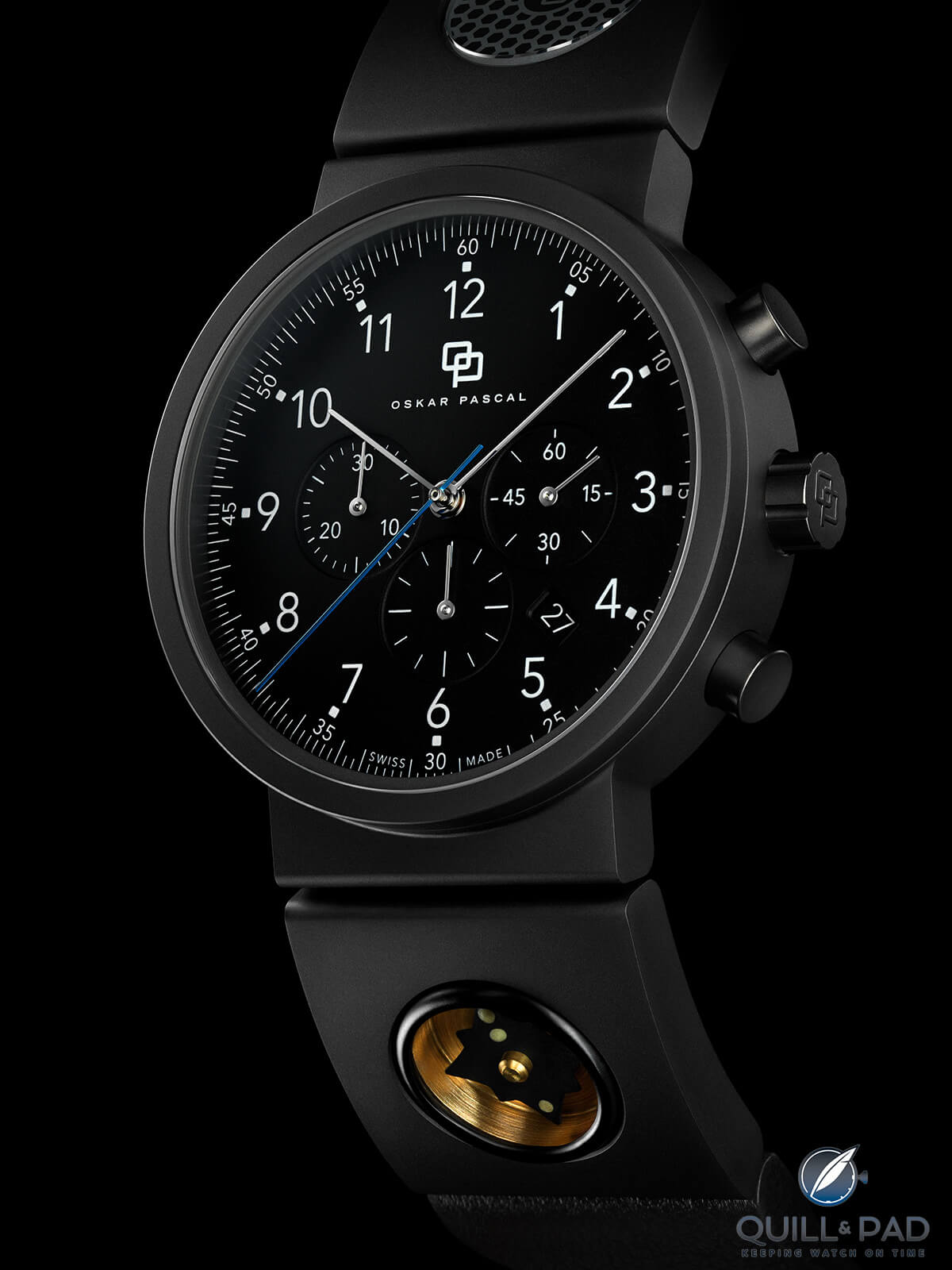
Oskar Pascal OP483 chronograph Space Grey with compass Pod
Right now, two patent-pending Pods are available. The first one, a compass, is compact and attractive, like masculine jewelry. The Francis Barker NATO Survival compass – also known as a button compass – is designed with military specifications in mind (specifically meaning it can be swallowed if the wearer gets captured by the enemy, to then reemerge the natural way to be used for a possible escape). “That’s what it was originally built for,” Paulin laughed when Devanthey jokingly asked if he had tried it out.
The two went on to explain that it is removable from its setting, too. “This is one of the most exclusive button compasses you can buy,” Paulin explained. “It only weighs three grams!”
The other sapphire crystal-encased Pod is equipped with NFC – a technology that many of us use in hotels to unlock doors, for example. There is no need for a battery or connectivity. As an example, this could be used with a car to open doors or start engines. Once the client orders this Pod, they specify which NFT system they’d like built into it.
The Pod system is fully customizable and interchangeable – or the customer can choose to leave the Pods out altogether. As the watch comes in a set with two straps and the tool, the owner is able to change out the Pods as desired.
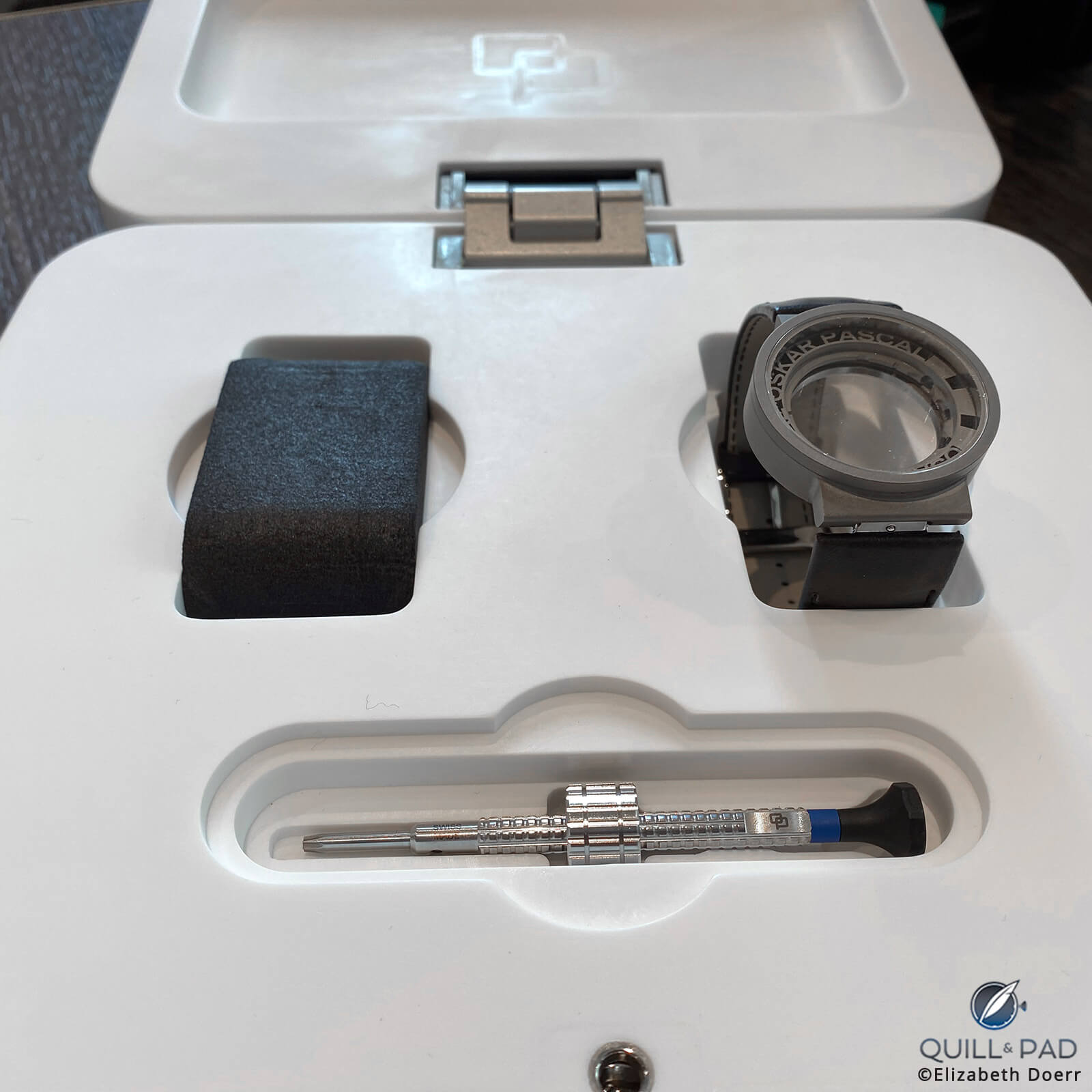
Oskar Pascal OP483 set (prototype)
Oskar Pascal is continually developing the modular technology system so that new Pods will be introduced in regular intervals. Currently, a mechanical activity monitor (step counter) with a separate rotor is under development, and after that a Pod for wireless payments is set to follow. “And we have at least another 30 ideas!” Petter exclaimed. “You can do so much – even simple things like building in a small pocket for pills.”
I envisioned Batman’s utility belt at that moment.
Oskar Pascal OP483: carbon fiber chronograph second hand
Also noteworthy is the chronograph’s second hand, which has an ultra-thin design with no counterweight; the brothers were really keen to have as thin a hand as possible at that position for design reasons. (This is part of what I would consider “Swedish design.”)
To enable this unusually thin chronograph hand without damaging the movement, Devanthey and the Paulins had to do some thinking outside the box. The solution ended up being a hand made of carbon fiber that is 0.28 mm thin with a weight of 0.002 gram; and it is stronger than a traditional steel hand.
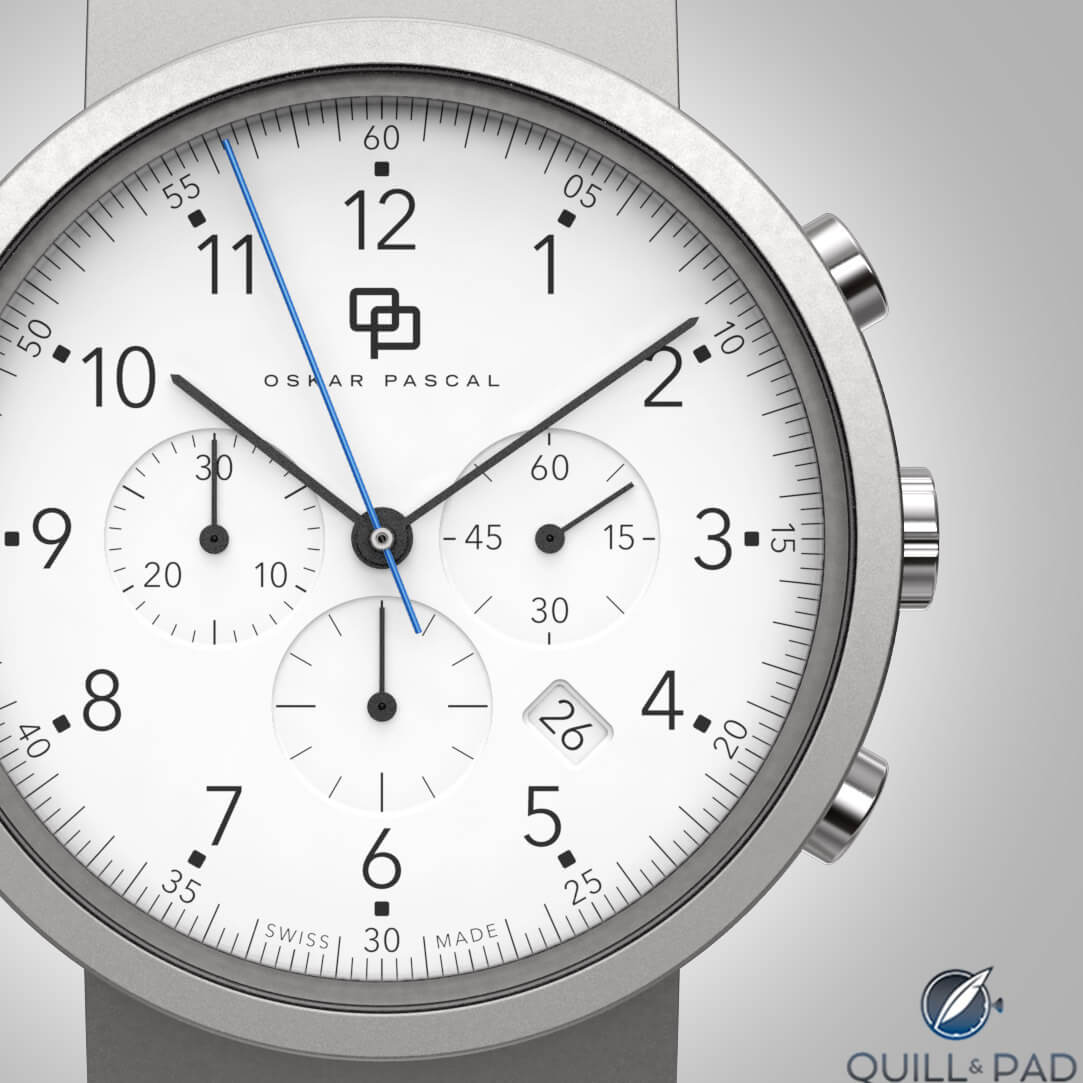
Oskar Pascal OP483 chronograph: note the carbon fiber chronograph hand
This hand exists because but they could not get it made using conventional metals, so they hit upon the idea of using ultra-light carbon fiber. “Then we called around in Switzerland, and it seems no one else has ever made a carbon fiber hand before,” Petter reported.
So they purchase the carbon fiber in sticks and Devanthey’s workshop fashions the hands. “We had to make special tools to be able to cut the carbon fiber,” the watchmaker reported. It is lacquered in a strong blue tone ensuring great visibility and contributing to the unique design of the watch.
Devanthey designed the center tube in ARCAP – also known as German silver, a material that Urwerk also often uses for solutions – to accommodate this unusual hand. “And I made the first two prototypes myself to make sure it all worked,” Devanthey said.
Against the white dial, the contrast of this special hand is very easy and pleasing to the eye. On the darker black dials, the hand is painted a slightly different shade for good visibility. No detail has been left to chance.
Oskar Pascal OP483: Cyrano Devanthey and the mechanics
The mechanical movement of this watch is not the thing that sets it apart from others in its price class. However, it is important to note that the Paulin brothers spared no expense to make the mechanics the best they can be without needlessly spending millions on developing a new chronograph movement.
“It’s kind of tricky as a new brand from outside of Switzerland to find suppliers,” Petter Paulin explained. But they were able to get a meeting with Vaucher and are very happy with the high-quality movements. “It still took us four months to get approved as a client!”
Around the same time that the Paulins found Vaucher, Devanthey and his business partner Dominique Buser were recommended to them for the engineering and technical parts of the watch: their job is to ensure precision, maintain water resistance levels, and fit the general construction together.

Dominique Buser (left) and Cyrano Devanthey in their Buchs, Switzerland workshop
Aside from many illustrious years working at Omega, which included managing the production of the Omega Central Tourbillon, the world’s first production wristwatch with a central tourbillon, Devanthey and Buser’s work with Urwerk’s R&D department is well known. Another of their projects was developing and making Experiment ZR012 for C3H5N3O9, a joint venture by Urwerk and MB&F.
Devanthey and Buser have engineered the inside of the Oskar Pascal case and different parts of the link system to be compatible with the Vaucher Manufacture chronograph movement the Paulin brothers chose.
And there is no movement ring holder – the movement is screwed directly to the case using original contact points of the movement. This is only one of the practical technical elements that the Devanthey/Buser team made the effort to add to the engineering.
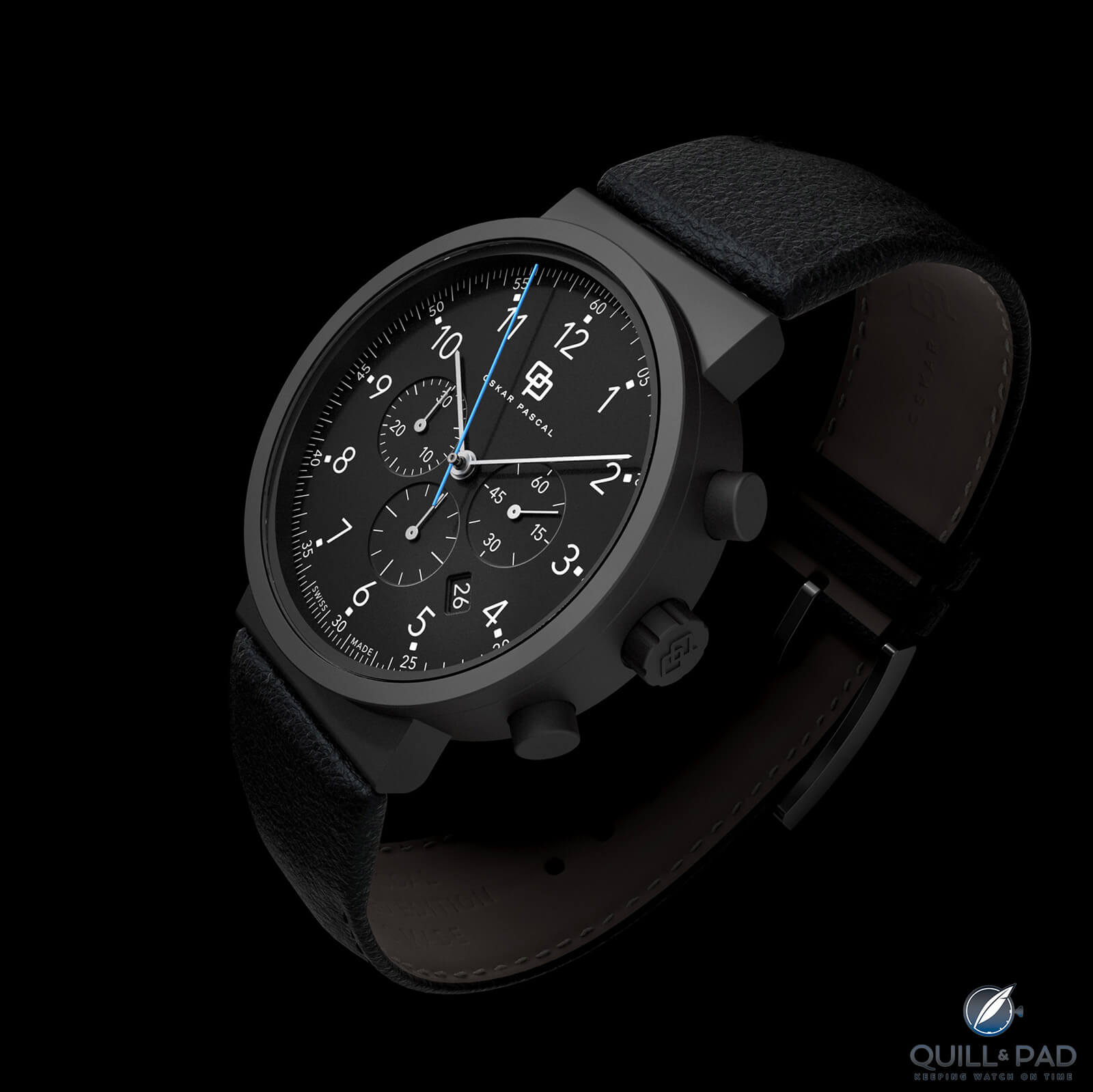
Oskar Pascal OP483 Space Grey
“[The Paulins] didn’t choose the easiest path: a new extreme metal, Pods, a special link system, and hands in carbon fiber. This was never going to be an inexpensive timepiece,” Devanthey remarks of the Oskar Pascal OP483. “But the result is a unique and beautiful high-end watch.”
While Devanthey and Buser had been pretty exclusive to Urwerk since 2009, and then their own independent brand Oscillon, the pandemic years 2020 and 2021 have seen them add other independent clients.
Vaucher Manufacture movement
Founded in 2003, Vaucher has become a player of significance in the watch industry. Vaucher is one of the very few independent movement producers left as other high-end producers such as ETA and Frédéric Piguet have been largely limited for use within the groups they belong to.
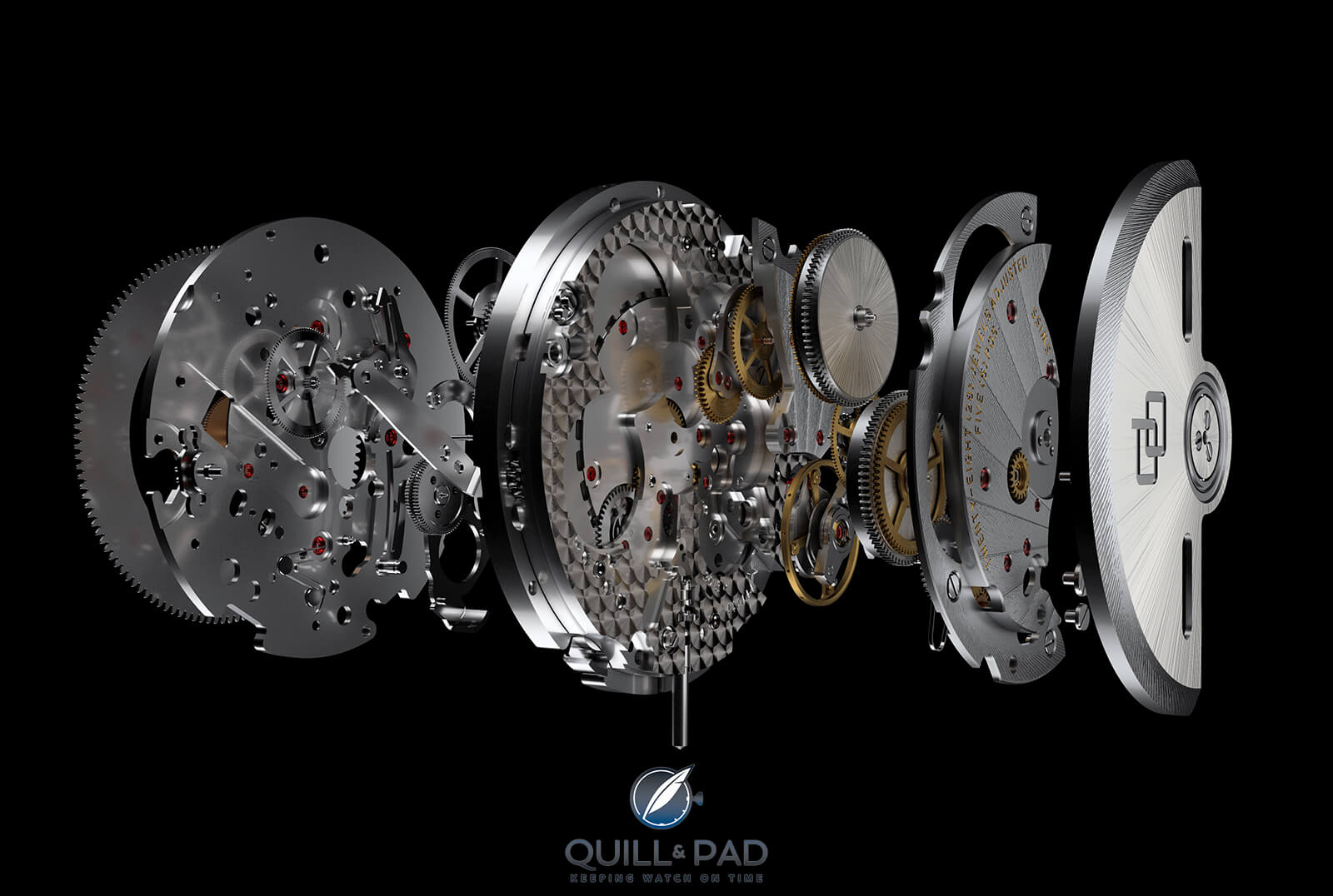
An exploded view of the Vaucher chronograph movement in the Oskar Pascal OP483
As part of the Sandoz Family Foundation, Vaucher boasts a naturally close relationship with Parmigiani Fleurier, but Hermès also owns 25 percent of the factory that exclusively manufactures its movements. Vaucher also boasts a number of very high-end clients, among them Richard Mille.
Vaucher, who also supplies other high-end watch brands with high-quality movements, mixes traditional crafts with cutting-edge technology in its production processes. Whatever yields the best results. Sophisticated and advanced CNC machines dominate one room, but just down the hall an artisan is likely hand-beveling a bridge.
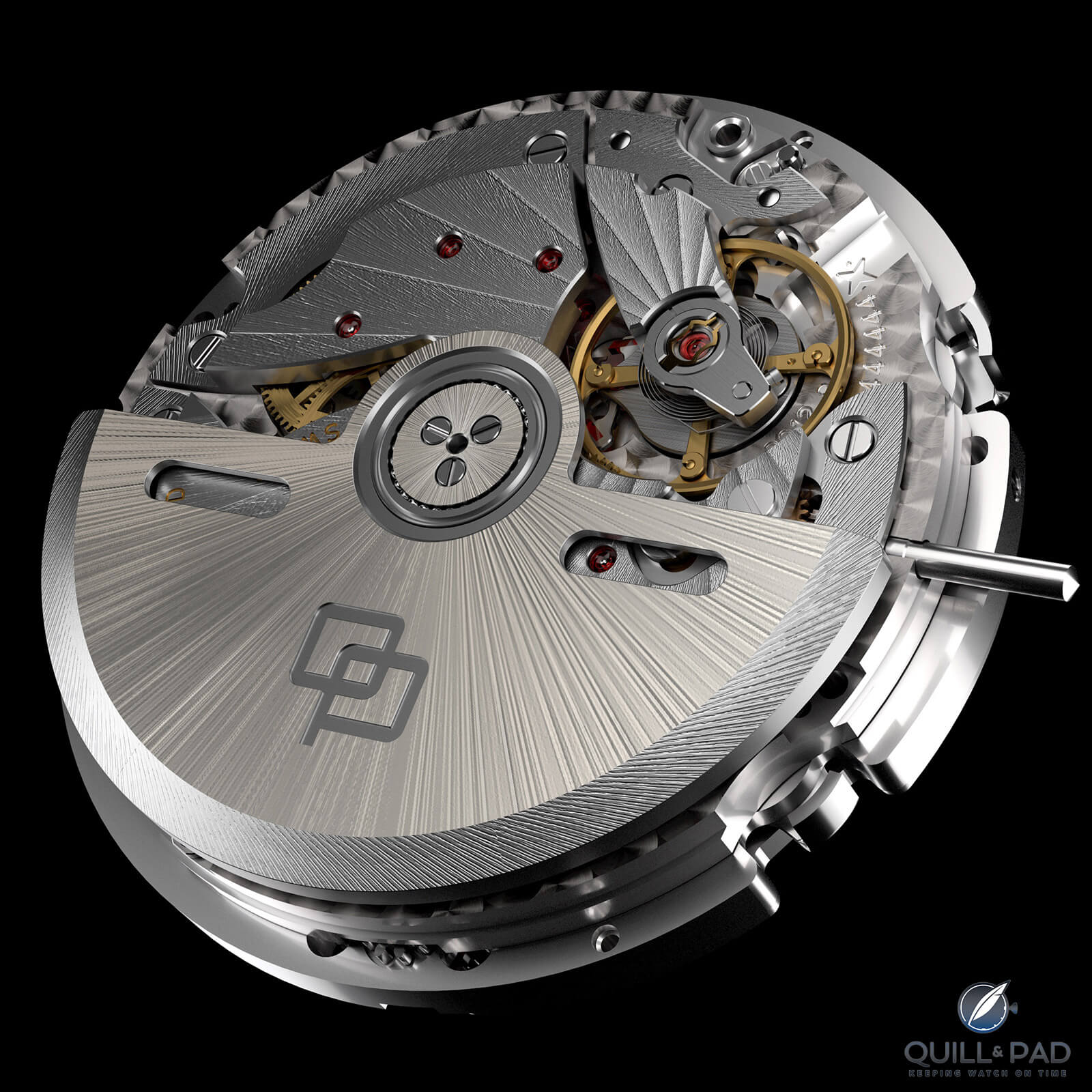
Caliber OP-X (Vaucher Manufacture Caliber 3022/12)
The Paulins use Vaucher Manufacture Caliber 3022/12 to power the OP483 chronograph. It has been personalized for the Swedish brand with a special rotor.
Closing notes
The Oskar Pascal OP483 falls into the premium segment above €30,000, which isn’t necessarily unusual for a new independent brand of this quality. I believe these watches are very much worth looking at if the clean Swedish design and almost futuristic style of the ZR01 case and unique Pod system appeal to you.
“We just aren’t an ‘average’ watch,” Petter Paulin summed up. “And there are no Swedish brands in this price range at all.”
Every piece of the OP483 is custom-designed and -made, with the exception of the Vaucher movement inside. And even that has a customized rotor.
Petter Paulin, who has worked in design agencies for around 20 years, designed the watches himself. “Well, actually, both Jakob and I did the design of the case together – even though he’s not a ‘designer’ he’s very skilled in design, I would say. We like that really clean look.”
I do like the date window, which is invisible if you want it to be and visible if you need to see it. It’s just perhaps a tad small for people of a certain age, though.
The chronograph subdials and date window are all recessed without borders, so they blend cleanly into the design of the dial as a whole. Every marking on the matte black or white dial is precision pad printed.
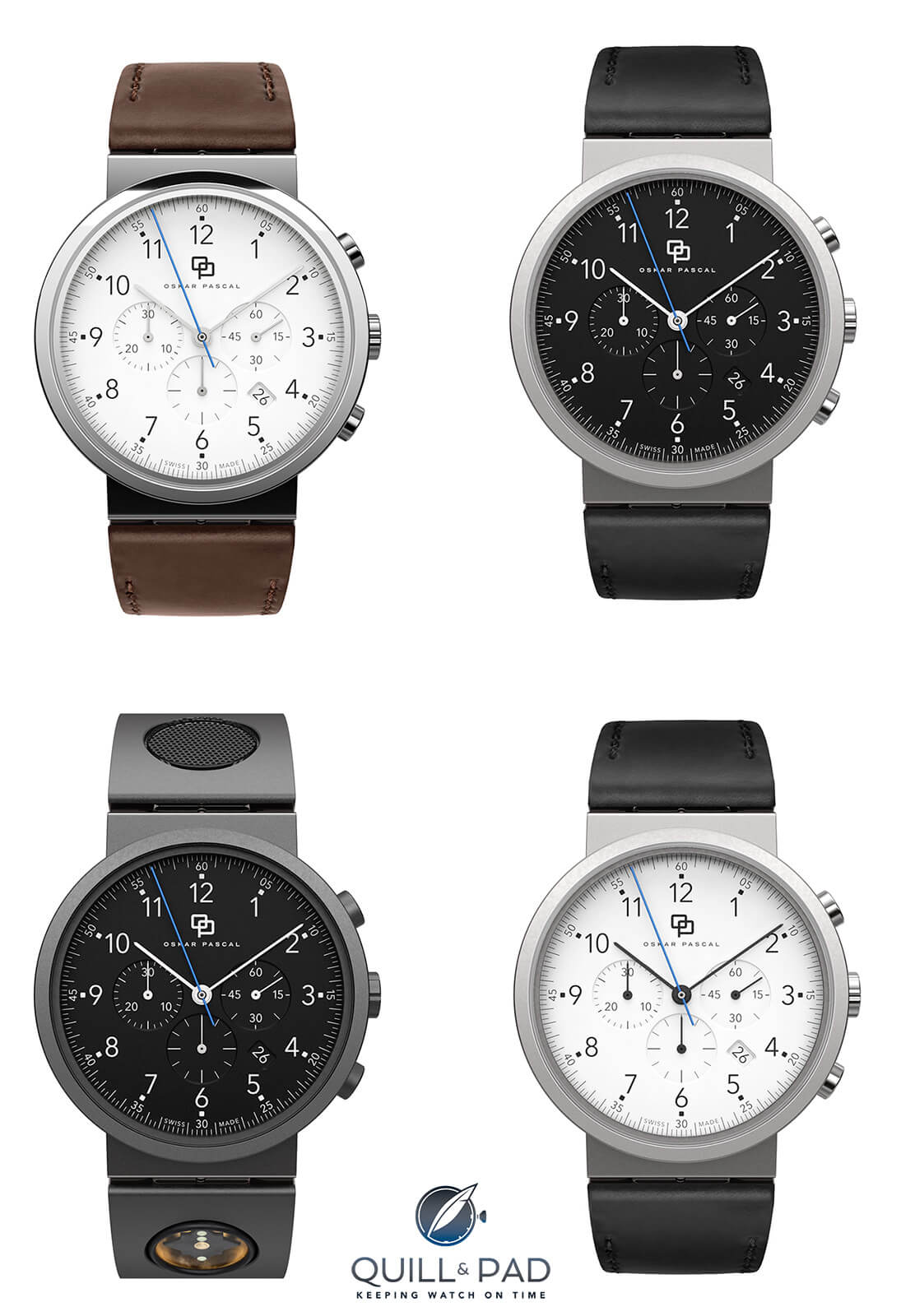
A few variations of the Oskar Pascal OP483 chronograph
Trying on the prototype, I was surprised by the astonishingly good fit, even on my small wrist. Not too heavy, and certainly not disproportionate. The case comes in its natural warm-steel color in a matte sandblasted finish, a darker DLC-coated variation called Space Grey, or an ultra-shiny, high-polished version of the natural color (Ultra Shine).
One thing that I find to be a less elegant solution is the closeness of the chronograph subdials to the center of the dial, which was actually predisposed by the mechanics of the movement in combination with the wide, practically bezel-less dial. But that is likely just my taste. The rest is very clean, very clear.
There is a five-year warranty on the watch, and it can be ordered through Oskar Pascal’s website; delivery time should be within three months.
For more information, please visit www.oskarpascal.com.
Quick Facts Oskar Pascal OP483
Case: 41 x 12.3 mm, amorphous ZR01 or DLC-coated ZR01, sapphire crystal case back, optional Pods
Movement: automatic Caliber OP-X (Vaucher Manufacture Caliber 3022/12), 45-hour power reserve, 4 Hz/28,800 vph frequency,
Functions: hours, minutes, seconds; date, chronograph
Limitation: 483 pieces
Price: starting at €38,500 without Pods on a calfskin strap
You may also enjoy:
Philippe Dufour Explains The Goals Of Time Aeon And Oscillon (Video)
Focus On Technology: 3D Printing, What Is It Really?
Focus On Technology: 3D Printing, What Is It Really? Part Deux
Leave a Reply
Want to join the discussion?Feel free to contribute!





















































I had not formed an opinion on this watch, but I felt I should like it. I was looking for clues as to whether it was “pure” or boring; precise or an homage to mediocrity, via Apple, Ralph Lauren and page 1 of literally any coffee table book with the word “Design” in the title. And then I saw the date complication.
All that effort. All that talk of “The Swedish School”.
For nothing.
A pair of Swedish brothers neither watchmakers or previously in the watch industry, designed by someone who is ‘not a designer’ and we see ‘their’ first watch. Swiss Made – pretty much what we can expect 🙂 and using..zirconium. Did Omega help?
The dial looks like a cheap fashion watch from anybrand. Sorry, but there it is.
Dieter Rams please come back. I cannot believe the asking price for this .Maybe include more than a pedestrian power reserve?
https://www.braun-clocks.com/collections/watches
This is so similar it is ridiculous
Congratulations on a stunning watch. I would change the date window though so that the date display is not angled.
Man I love the tech and the movement, but the dial looks like something that should be on a Daniel Wellington or some other $0 fashion watch. I personally would not have that dial on my wrist, could have done so much better with a little stronger dial design!
How much is the cost of the watch
Price and website url are at the bottom of the article.
Regards, Ian